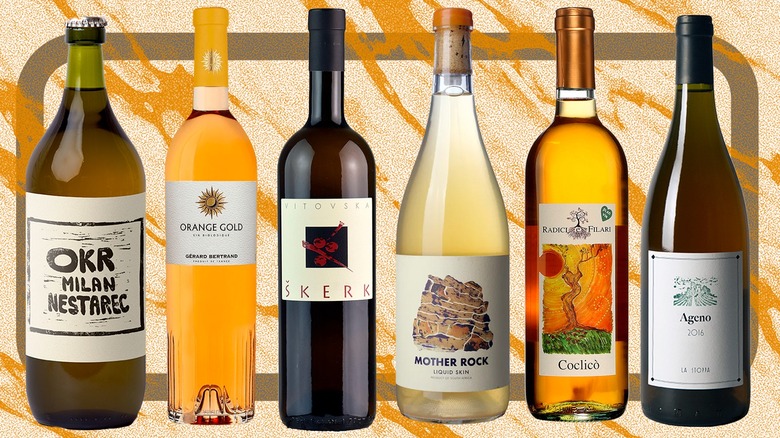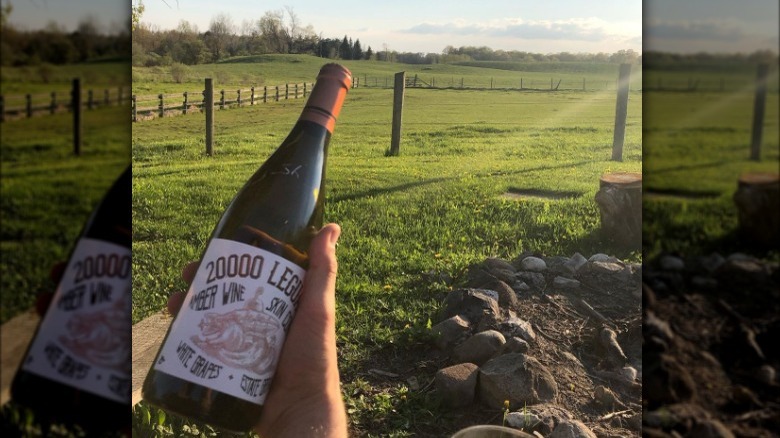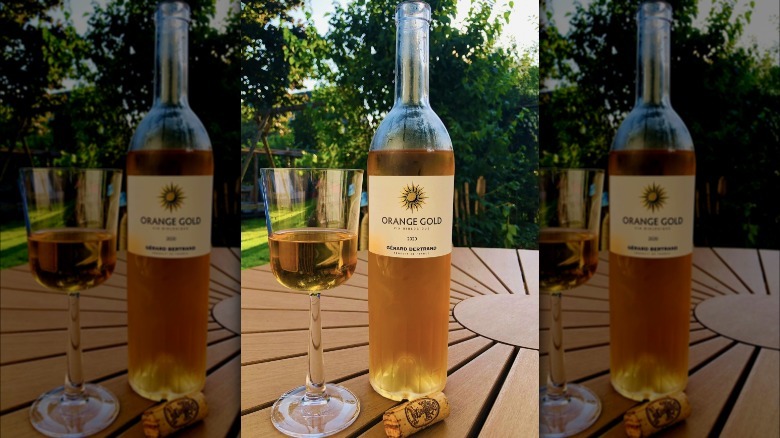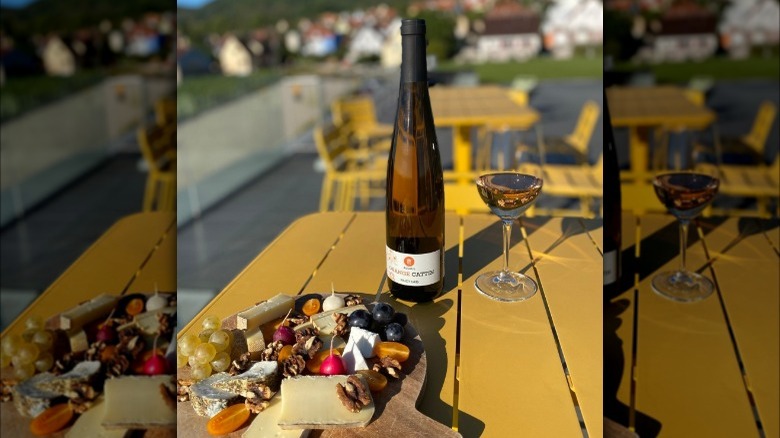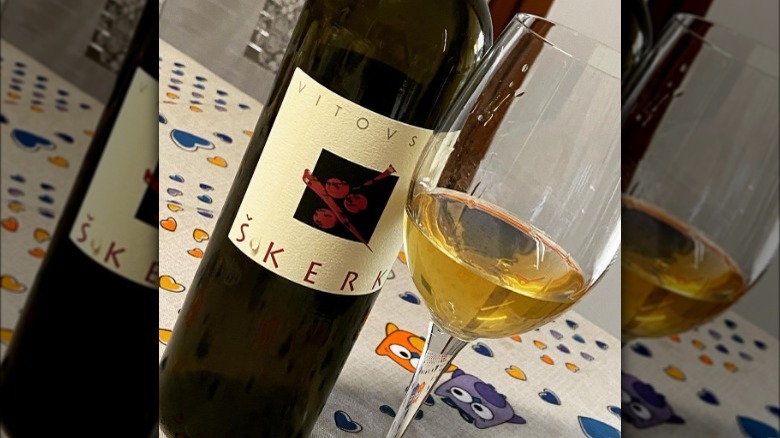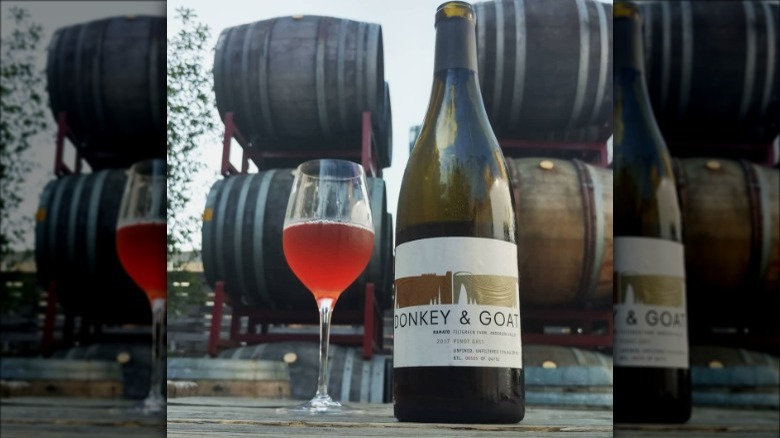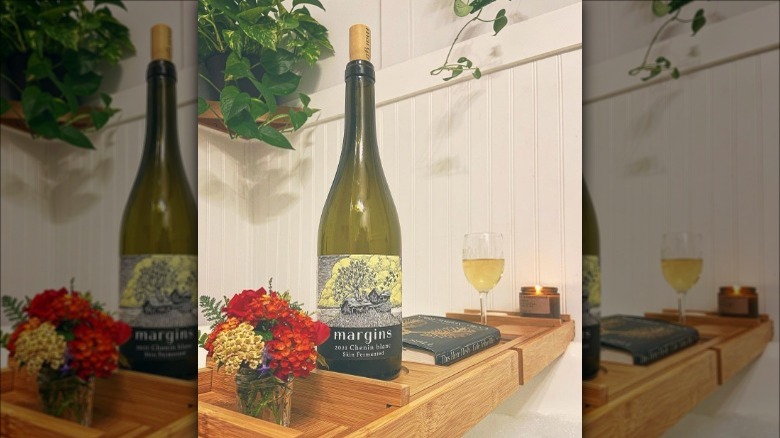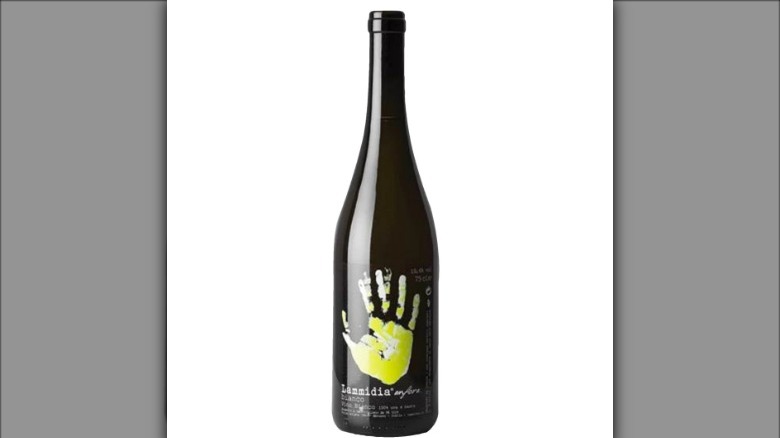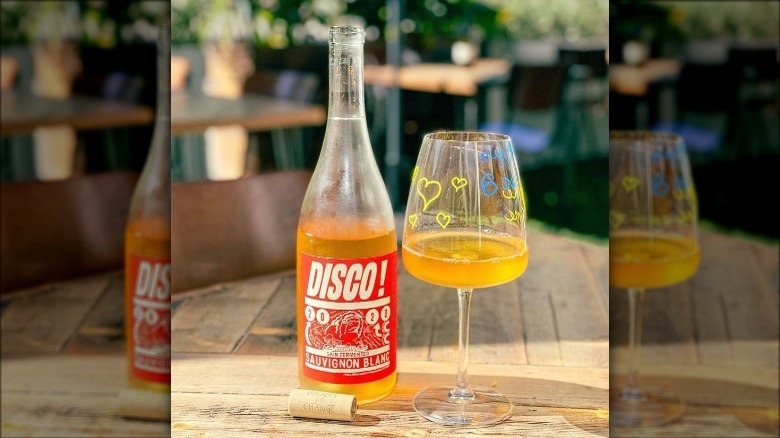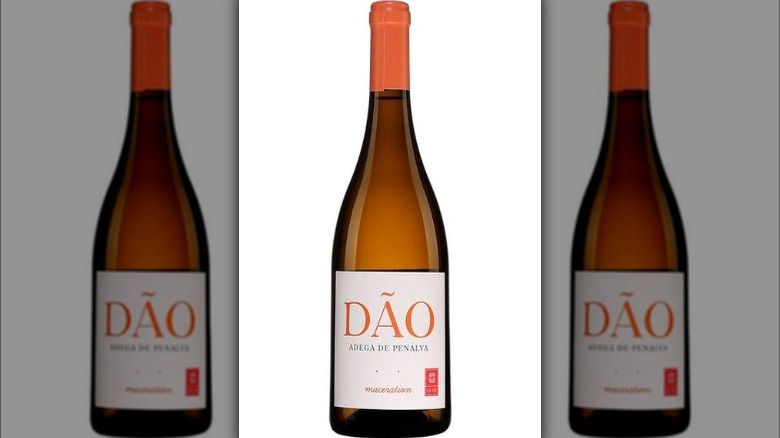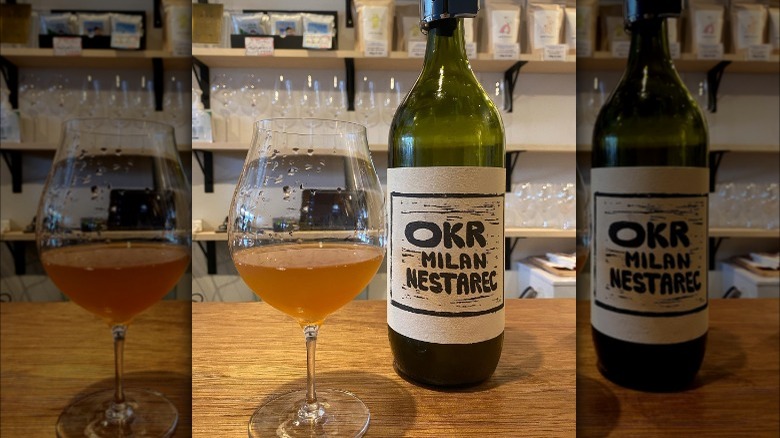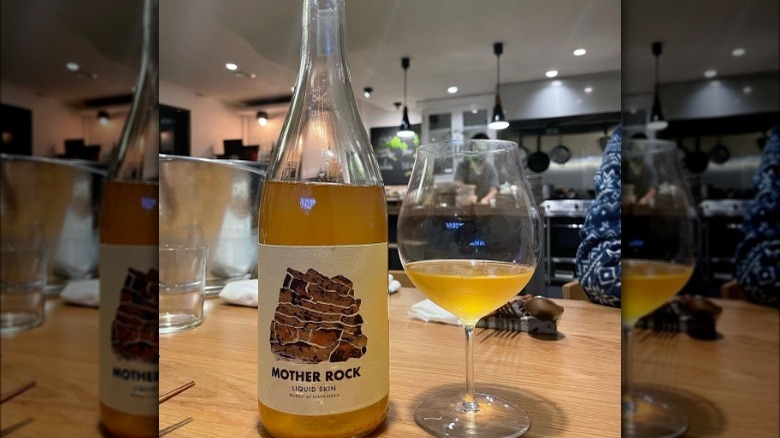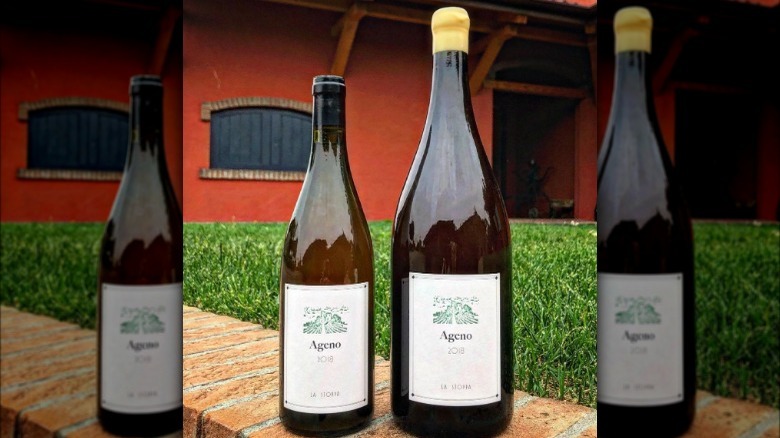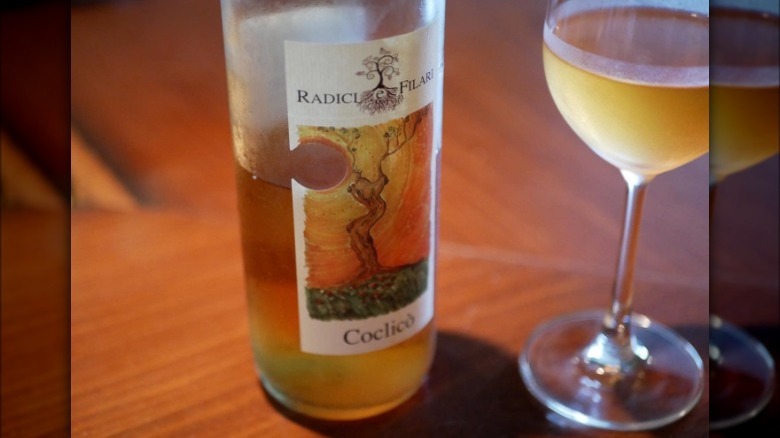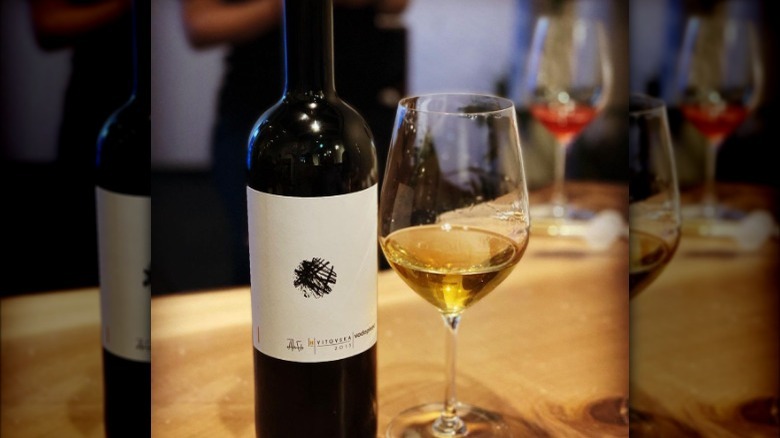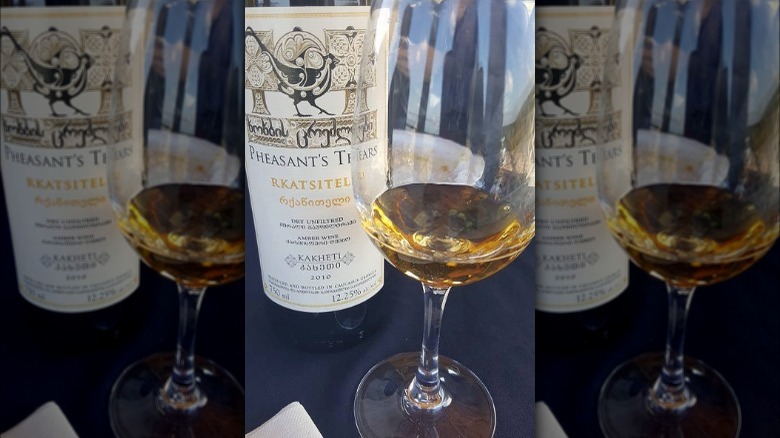15 Delicious Orange Wines, Ranked
If you've boarded the orange wine train, then you'll be familiar with the wide range of styles in this category. On the other hand, if you're wondering why they've started adding oranges in with the grapes, let's backtrack. In this case, orange is a descriptor of the wine's visual appearance, though it varies broadly from pale orange to deep amber. A more accurate label is skin-contact or macerated wine.
When white wine is produced, the grapes are pressed and quickly removed from their skins to avoid any coloring. With red wine, the skins are kept in contact with the juice for the very purpose of infusing color. Orange wine is made with white wine grapes that undergo a process more akin to red winemaking, resulting in skin contact with the juice. Winemakers can opt for a shorter or longer duration of maceration, which is the main factor influencing the final color.
Wine grape skins all offer their own nuanced hues and aromas, making orange wine a multifaceted option if you're looking for something beyond the usual trio of colors. Thanks to its popularity over the past several years, an increasing number of winemakers are keen to experiment with the style. That being said, it's not new by any means; its production spans a couple of thousand years and can be traced to what is now the country of Georgia. It's expanded across the world by now, so here is our ranking of delicious orange wines.
15. Dominio de Punctum — 20,000 Leguas
Dominio de Punctum is a family-owned winery in Cuenca, Spain, that practices a biodynamic and organic viticultural approach. With vineyards at over 2,600 feet above sea level, the wines boast concentrated flavors and a fresh quality. Thanks to a wide diurnal temperature range between the sunny daytime and cool nights, the fruit maintains acidity while fully ripening.
With a nod to Jules Verne, 20,000 Leguas is an amber wine made with chardonnay, viura, and verdejo grapes. Although the color isn't especially deep, the flavors stand out. Tropical fruit, apple, citrus rind, and nuttiness are noticeable on the palate, with light tannins that make it a good match for fattier foods. Serve it with fried fish tacos and guacamole or pair it with a bold cheese or apple-based pork dish. There's nothing too weighty about this wine, so you're sure to enjoy its juicy profile without food too.
14. Gérard Bertrand — Orange Gold
Famed Southern French wine producer (and former pro rugby player) Gérard Bertrand's namesake winery is known for its wide range of styles and price points. From easy-going weeknight wines to complex age-worthy numbers (as well as some iconic rosés), the multi-vineyard estate covers all of its bases. Although the different lines of wine have varying approaches to viticulture, a focus on maintaining biodiversity and sustainable practices in harmony with nature is at the forefront.
Per the winegrower, Orange Gold is a symbol of the beauty of the sun, notably the sunsets of Southern France. Whether you have the chance to sip this wine at a coastal café or serve it to brighten up a gray winter day, its vibrant nature will liven up any occasion. Made with a blend of white grapes including chardonnay, grenache blanc, muscat, and viognier, this wine is blooming with heady aromas. Stone fruits and flowers mingle in each velvety sip, and light tannins from the two or so weeks of skin contact keep it structured yet fresh. Serve this sunny wine with spicy dishes such as a coconut milk curry, or pour it alongside a selection of cheeses.
13. Joseph Cattin — Orange Cattin Pinot Gris
Alsace in France is an exciting place for viticulture, thanks to the many hours of sunshine it receives on a yearly basis. Family-owned Joseph Cattin winery is the largest of its type in the area, with three centuries of tradition backing it up. The focus is primarily on white grapes, with pinot noir as the token red and rosé, as well as a range of delightful sparkling wines.
Cattin's Orange Cattin pinot gris is its foray into orange wine, and given its success, we hope there's more to come. If you're still hesitating about this category, a wine made with a familiar grape and a short maceration period (two days) is a good way to dip your toe in the water. This full-bodied pinot displays generous citrus aromas, with notes of zest and candied peels. The spiced palate makes a great pairing for cuisines with spicy profiles, such as Thai and Indian. Try it with white meats, seafood, pasta, or a cheese and charcuterie combo — it's an all-around easy wine to pair.
12. Skerk — Vitovska
Some of the top skin-contact wines available come from the Friuli-Venezia Giulia region in northeastern Italy. The style is part of traditional viticulture, and the local indigenous grapes lend themselves well to it. Azienda Agricola Skerk prioritizes low yields and doesn't rely on chemicals and fertilizers to grow quality fruit. With climatic conditions influenced by the nearby Adriatic Sea, the Gulf of Trieste, and harsh Bora winds, the vines and resulting wine offer a unique glimpse into the terroir. Not to mention, the cellar itself was created by breaking through the rocky hills with dynamite.
If you want a proper introduction to the area of Carso that borders Slovenia, then a wine made from vitovska is a must. The local variety is a hybrid of glera (Prosecco's primary grape) and malvasia bianca lunga (yet another member of the malvasia family). The juice sits on the skins for 10 days, giving it time to soak up the aromas. The result is floral, with notes of apple, citrus, and a savory hint of salt. Thanks to some time spent aging in wood, the mouthfeel is pleasantly smooth and creamy. Serve this fuller-bodied wine with poultry, seafood, mushroom risotto, or a charcuterie board.
11. Donkey & Goat — Ramato Pinot Gris
U.S. producers are not sleeping on the orange wine hype, and numerous wineries across the country have skin-contact options in their portfolio. Donkey & Goat is an excellent place to start, as it has been at the forefront of the national natural wine industry for decades. With a clear spotlight on transparency, the winery sources grapes from vetted growers who share the same philosophies of minimal intervention both in the vineyard and cellar.
The skin ferment pinot gris is made in the ramato style from Friuli-Venezia Giulia and refers to the copper color of the wine. Slightly distinct from other types of orange wine, ramato is made with pinkish-gray grapes, typically pinot gris. While many pinot gris wines are completely clear, the grape skins are tinted a subtle pink-gray color. Consequently, the resulting color is more on the copper pink spectrum and can be confused with rosé.
Donkey & Goat's version is made with fruit from Anderson Valley, California. The juice is left on the skins for under a week, imbuing some color and tannins. The result exudes aromas of dried fruit, tea, rhubarb, hibiscus, and herbs. Pair it with quince jelly and cheese canapes, roast chicken, or a North African-inspired dish. Follow the winemaker's advice by serving it in the crisper autumn months as the skylight starts to fade to a coppery color.
10. Margins Wine — Chenin Blanc
Margins Wine is a California winery that focuses on sharing lesser-known varieties and vineyard regions (those on the margins of the standard) with the public. The range of wines is diverse but each is made following low-intervention practices in the vines and in the cellar. The winery's skin fermented chenin blanc is an ode to this grape, sourced from organic vineyards. The juice is kept in contact with the skins for just over three weeks, then aged in neutral oak barrels and bottled unfined and unfiltered.
The result is richly textured, with layers of complexity in every sip. An element of salinity is present on the palate, paired with a citrusy lime and tomatillo note. Tropical fruits and green apple add some dimension, while a mineral backbone makes this wine delightfully fresh. Serve it with spicy dishes, seafood, or a cheese board — it's sure to enhance even the simplest evening meal.
9. Lammidia — Bianco Anfora
With the slogan "100% grapes and enough," you can bet that Lammidia prioritizes a natural winemaking approach. Located in the Southern Italian coastal region of Abruzzo, the two founders are wine lovers turned vintners. The vineyards and cellar all come from their hard work and exploration of the region's possibilities. With a wide portfolio of wines, including various orange bottles, as well as rosé, red, and pét-nats, the duo clearly has a winning formula.
Bianco anfora is made with local trebbiano d'Abruzzo grapes that are fermented on the skins for one week in an amphora. Following a pressing, they continue to ferment and mature in the amphora until bottling. Citrus and tropical fruit flavors pair with warm spices and an herbaceous hint. You'll note some cloudiness in the glass as the wine is unfined and unfiltered, which only adds to the textural sensation on the palate. With a slightly lower alcohol content, this wine is perfect to sip solo or with food. Enjoy it with a classic pizza or serve it with grilled vegetables and a mixed cheese platter.
8. Subject to Change Wine Co. — Disco!
This California winery passionately produces natural wine, respecting its surrounding environment and leaving plenty of space for experimentation. With a focus on the community and sharing the local terroir with the world, these wines are a perfect reflection of its values. Among the varied selection, the Hillside Vineyard Disco! skin-contact sauvignon blanc is an excellent juicy number to get to know this winery.
A portion of the grapes undergo carbonic maceration, a process that keeps wines especially bright and lively on the palate. Notes of tropical fruits are present with a citrusy element that makes this utterly drinkable. Paired with balanced tannins and a long finish, you'll want to keep a bottle in stock at all times. Serve it with coconut curry, Moroccan dishes, or other meals seasoned with warm savory spices. It also makes a nice match for a seafood dinner or plant-based recipes, and of course, you'll want to enjoy a chilled glass solo.
7. Adega de Penalva — Skin Maceration
Portugal is especially well known for its vibrant Vinho Verde, complex red blends, and lusciously sweet Port wines. However, local winemakers are increasingly experimenting with various styles, including extended skin contact with white grapes. Adega de Penalva is a cooperative in the Dão region that makes wine with fruit from around 1,000 growers.
Its skin maceration wine is a blend of encruzado, malvasia fina, and cerceal branco, in almost equal parts. If you've never heard of these grapes before, they tend to stay pretty close to home. The juice only stays on the skins for around two weeks, making this a lighter less tannic style. Time spent maturing in oak barrels also helps smooth out the edges. The subtle aromatic profile is pleasantly fresh, with notes of stone fruit and a saline finish. Citrus zest adds a pep to each sip, while a hint of honey builds layers of complexity.
Keep your food pairings on the lighter side, such as by serving this with salad, seafood, poultry, a cheese board, or a summery pasta dish. Anything seasoned with lemon will highlight the citrusy aromas of the wine too.
6. Milan Nestarec — OKR
Czech producer Milan Nestarec is a noteworthy name in the natural wine world. True to his unique philosophy, the founder is quick to say that "Milan Nestarec is not a winery." He shares, "I'm not selling wine. I'm serving a world view." Nestarec eschews labels and refers to his viticultural practices as being normal. Working with a small team including his parents, the organic wines are made with great attention to quality and consistency.
OKR is a subtle take on orange wine (a term that Milan is also not so fond of), which makes it a good introduction to the style. The name itself refers to the word ochre, a type of natural clay that comes in shades of orange. Chardonnay, grüner veltliner, sauvignon blanc, and gewürztraminer come together in this fruit-forward, zesty, and herbaceous wine. With notes of pomelo, passionfruit, and pineapple, there's a vibrant tropical allure to this wine that fits Nestarec's description of its "everyday easy drinking vibe." The zingy fresh flavors are a hit whether you're sipping it solo or serving it with food. Plus, this is the perfect bottle to keep on hand if you're hosting as it comes in a convenient 1-liter format.
5. Mother Rock Wines — Liquid Skin
Swartland, South Africa, is home to some of the nation's oldest vineyards and most experimental winemakers. Mother Rock Wines is one of the labels of two passionate vintners seeking to showcase the region's diverse terroir. Sourcing grapes from a variety of organic and biodynamic vineyards, the process in the cellar is equally minimal to truly highlight the natural product. With a primary focus on chenin blanc, South Africa's number one white wine grape, the winemakers have a varied portfolio that includes Liquid Skin.
This orange wine is made with chenin blanc and about two months of maceration on the skins. Then, the wine ages in concrete eggs without any additives, leaving consumers with the pure unadulterated expression of the vineyard. The result is packed with flavor, with notes of tropical fruits, kumquats, stone fruits, honey, and nuts. A chalky minerality freshens up every sip, while an earlier harvest date keeps the acidity notably present. This is an excellent candidate to pair with food, from aperitif bites to seafood dishes or a spicy curry. At least one internet reviewer even believes it might be too easy to drink.
4. La Stoppa — Ageno
La Stoppa winery in the Italian province of Emilia-Romagna is a testament to the notion that agricultural practices that are in tune with the environment produce amazing results. Apart from minimal additives in the vineyard (no herbicides or fertilizers are used), the process is a careful collaboration between humans and the natural world. Vintners work by hand in the vineyard to harvest and prune indigenous varieties. Nothing is rushed; fermentation occurs spontaneously and the wines are slowly matured until ready.
Each step paves the way for wines that offer unique qualities of the regional terroir. Ageno is surely one of the winery's proudest creations since it was given the name of the founder. The wine is primarily made with malvasia di Candia aromatica, one of many grapes in the malvasia family. The color is the result of four months of skin contact, offering a deeper foray into the complexities of orange wine.
Notes of stone fruit are complemented by flavors of tea, spices, and flowers. Thanks to the lengthier maceration, notable tannins make this a suitable option to pair with a range of foods. Lean into the Italian origins and whip up a saucy plate of pasta or pour a glass with a selection of antipasti, cured meat, and pungent cheeses.
3. Radici e Filiari — Coclicò
Once again, Italy is the source of another exciting orange wine to add to your bucket list. Family-run business Radici e Filiari is located in the Langhe and Roero regions of Piedmont. While the area is known for its bold red wines, local grape arneis leads among the white wines. Coclicò means a poppy flower, and in this case, it refers to the orange variety.
The winemaker shares that vinifying arneis with skin contact has long been a tradition in the region. However, prominence dropped in 1990 with the creation of a DOC (Controlled Designation of Origin) for arneis. While Coclicò is not categorized in the DOC, it speaks nothing of the quality. Grapes are hand-harvested and the juice is fermented with indigenous yeasts followed by a light hand in the cellar.
The result is fresh and lively, with notes of dried fruits, citrus, and flowers. The wine has a balanced finesse and a fullness that makes it suitable to stand up to meat or vegetarian pasta dishes, cheeses, and herbaceous preparations. It's also delicious served alone or as an aperitif with salty snacks.
2. Vodopivec — Vitovska
Another star player in the north-eastern Italian wine scene, Paolo Vodopivec is known for his focused approach to winemaking. With a staunch reliance on using only what is naturally available, the carefully crafted wines are a true testament to the local terroir. With nothing added and nothing removed, this is the vitovska variety at its purest. Vodopivec currently only makes wines with this indigenous grape, so you can expect its inherent qualities to be highlighted in each bottle.
Having learned a great deal from famed natural winemaker Josko Gravner, Vodopivec's style shows notable influence within a slightly more accessible reach. These are not inexpensive everyday wines, but the price tag is reflected in the laborious process that culminates in each bottle. Vodopivec hand-harvests fruits and lets native yeasts initiate fermentations. The wine is also fermented in an amphora, a traditional urn-shaped clay vessel that is commonly buried underground.
Stone fruit and earthy notes mingle on the palate, with a minerality that stands out. The wine is lively and textured, with a chalky finish reminiscent of its rocky origins. Serve this with cured meat, bold cheese, savory pasta, and spiced seafood dishes.
1. Pheasant's Tears — Rkatsiteli
You can't talk about skin-contact wine without exploring a bottle from the country of Georgia, where it likely began. Pheasant's Tears highlights local winemaking traditions, growing ancient indigenous grapes that can't be found elsewhere. All the wines are fermented in large clay vessels lined with beeswax called qvevri that have been used for thousands of years (though those at the winery are only a couple of centuries old). Uniquely, qvevri are typically buried underground where the temperature remains constant, guaranteeing a stable environment during fermentation.
Rkatsiteli is one of Georgia's primary white grapes and a common candidate for local orange wines. Pheasant's Tears' take is complex and savory, with notes of citrus and dried rinds. Due to its extended maturation in a qvevri, the wine displays an oxidative style that adds a layer of nuttiness. With tannins reminiscent of a strong cup of tea and stonefruit aromas, this is a multifaceted bottle. It pairs nicely with eastern European or Middle Eastern cuisines, or serve it with lamb, charcuterie, cheese, or a poultry dish.
